The Southern Appalachians stretch a long arm of New England deep into Dixie. Down that spine of summits, the East’s highest, snowfall can accumulate to astounding depths that defy stereotypes of the Sunny South.
When the snow closure signs go up on portions of the Blue Ridge Parkway, the Skyline Drive in Shenandoah National Park, and the Great Smoky Mountains — cross-country skiers and snowshoers are often seen striding and stomping into a winter wonderland. As far south as North Carolina, lofty locations receive more than 100 inches of average annual snowfall—equal to Buffalo, New York. That kind of “accu” doesn’t all come down in three-inch dustings.
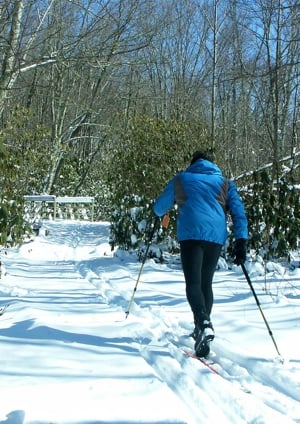
The Price Lake Trail on the Blue Ridge Parkway offers lots of room for kick-and-glide. Randy Johnson photo.
Even an average Appalachian winter in North Carolina or Virginia yields opportunities to find a substantial base of snow and enticing Nordic ski and snowshoe conditions.
Here’s a primer on the places where our national parks offer a “secret season” of winter recreation in a region more associated with sun than snow.
Both Shenandoah and the Blue Ridge Parkway straddle the eastern-most “front range” of the Appalachians. That can mean that most of the snow from the region’s storms falls on more westerly ridges (West Virginia peaks can receive nearly 200 inches of snow!).
Nevertheless, when the snow strikes, Shenandoah is only an hour or so away from urban areas like Washington, D.C., and Richmond.
Skiing or snowshoeing in the highest part of the park requires driving the Skyline Drive. The Drive is often closed after heavy snow, but the park routinely plows the road.
“Safety will always be number one,” says Chief Ranger Leslie Reynolds, “but we always want to open our roads as soon as safely possible.”
When open, skiers and shoers head south from US 211 to the area of Big Meadows, a summer recreation and services area known for high elevation grassy fields.

You can ski, or snowshoe, to the Old Rag Shelter in Shenandoah National Park when there's ample snow. Randy Johnson photo.
The meadows are great for Nordic skiing, so is Big Meadows Campground and a wealth of nearby fire roads and level stretches of the Appalachian Trail.
Chief Reynolds notices people heading down “the fire road to Rapidan Camp,” President Herbert Hoover’s fly fishing retreat. And the scenic Limberlost Trail offers a great loop tour of about 2 miles, while Hawksbill, Shenandoah’s highest summit (4,049 feet), can be tackled on a loop formed by fire roads and the Appalachian National Scenic Trail. A stone trail shelter sits on its summit (no camping is permitted).
When the park is really dumped on and the Drive is closed, head to the Old Rag area. Public plowed roads reach the park’s eastern boundary near adjacent small settlements of Nethers and Syria. The summertime loop of Old Rag’s rocky Ridge Trail is immensely popular, but winter can be quiet. From the trailhead parking area, mountaineers and energetic snowshoers might head left up the Ridge Trail.
Skiers should consider touring the Weakley Hollow Fire Road, a long gradual climb into the valley between outlying Old Rag and the main ridge where Hawksbill crowns the park. For lunch, take a left to the Old Rag Shelter (also no camping). From there it’s all downhill back to your car.
Peaks of Otter
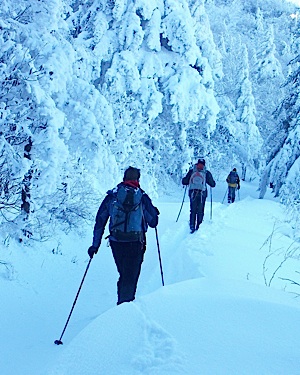
Mount Mitchell and high Parkway peaks routinely receive big snow. Randy Johnson photo.
The Parkway’s best-kept-secret in Virginia is the Peaks of Otter just north of Roanoke. Virginia highway 43 crosses the Parkway between Bedford and Buchanan, actually running along the Parkway for five miles in a “staggered” crossing. That gives great access to some of the high road’s most spectacular scenery.
Conical Sharp Top pierces the sky and Flat Top bulks beside, both towering above Abbott Lake. Sharp Top is a wonderful, strenuous winter hike of 3-miles round-trip. An easy 1-mile trail loops the lake, and a variety of other moderate trails make nice snowshoe walks or ski tours.
Peaks of Otter’s appeal climaxes at Peaks of Otter Lodge. This is the only Parkway concession accommodation that is open in winter. It sits beside the lake with awesome views and effortless access to great trails in the snowiest weather. The Lodge has a nice restaurant, lounge and gift shop, too.
North Carolina High Country
The High Country corner of northwestern North Carolina is a hotbed of Nordic ski enthusiasm. The High Country Nordic Association is sponsoring its annual Tele-Fest January 21st at Beech Mountain Resort, the East’s highest ski area and one of three downhill slopes in the area.
The college town of Boone and the resort towns of Blowing Rock and Banner Elk are the destinations. Granted, expert local skiers focus on the East’s highest summits, Mount Mitchell and Roan Mountain, both well over 6,000 fee. But the Parkway has a wealth of ski options when the snow cooperates.
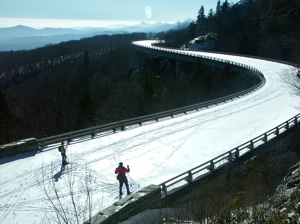
When closed due to snow, the Parkway's Linn Cove Viaduct makes a monumental ski tour. Randy Johnson photo.
The Parkway is lower, generally 4,000 or so feet, but its easier paths attract beginners and advanced skiers.
As with Skyline Drive, the National Park Service routinely plows part of the Blowing Rock portion of the road. That offers access to the Price Lake Trail, a nearly 3-mile loop around the Parkway’s largest lake. Check out this video with snow scenes.
Other trails are easy to reach from public roads, including the carriage roads at Moses Cone Park. Cozy tours lead through towering groves of snow-muffled white pines and up to open vistas of Grandfather Mountain on Rich Mountain and Green Knob.
The Tanawha Trail, part of North Carolina’s Mountains-to-Sea Trail, leads across meadows with links to Grandfather Mountain, a rocky state park summit beside the Parkway that challenges even serious mountaineers.
A bit farther south, near the High Country town of Linville, the Roseboro Road crosses the Parkway permitting a tour of the Flat Rock Nature Trail, with views west to the Appalachian Trail.
Parts of the Parkway here are gated under snowfall and make great tours. A favorite is the tour out over the famous Linn Cove Viaduct span on Grandfather Mountain. When the Parkway is open to Mount Mitchell—admittedly a rarity, but worth the effort to call ahead (828-675-4611)—snowshoers and skiers have the memorable opportunity to ski and hike the East’s highest summit (6,684 feet).
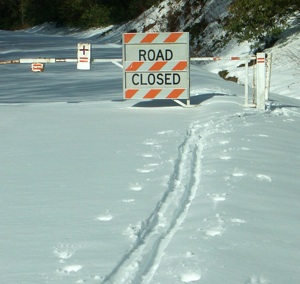
When snow closes the gates along the Blue Ridge Parkway, the skiing or snowshoeing can be great. Randy Johnson photo.
At times there’s also great skiing and snowshoeing on the southernmost section of the road, in the area of the Shining Rock Wilderness south of Asheville, and from Soco Gap, closer to the Great Smokies. It’s easy to assess road access—the Parkway’s road conditions info line is always updated for those who want to drive on the road or locate gated sections for ski touring or snowshoeing. There’s also a cross country ski report available online for the High Country area.
Great Smoky Mountains National Park
The Smokies might lie pretty far south—but no other mountains lie to the west to sap the snow from storms. The Smokies’ ridge is so abrupt and massive—rising from 1,000 feet near Gatlinburg to nearly 7,000 feet—that the highest peaks can get hammered by big snow in even marginal conditions.
Snowstorms often interrupt travel across the park on US 441, the Newfound Gap Road, but the public highway is such a critical transportation link that plowing is routine.
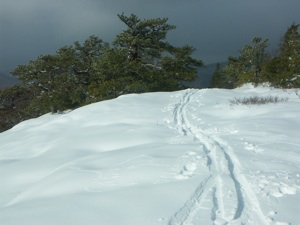
Vast views await on even easy Parkway paths. Ski tracks on the Flatrock Nature Trail, Milepost 308.3. Randy Johnson photo.
That allows easy access to Clingmans Dome Road, one of the South’s great skiing and snowshoeing sites. The Dome Road, which climbs seven miles from US 441 to the parking area for the park’s highest peak, is closed and unplowed from December through the end of March.
Take that ski tour, and along the way, the Spruce Fir Nature Trail provides a neat half-mile side loop that makes a nice turn-around point for a nearly 6-mile tour or snowshoe from Newfound Gap. The tour to the top of Clingmans Dome requires a 15-mile round trip—but it’s all downhill on the way back!
Of course, all the South needs is snow for these and other sites to offer great winter recreation. Luckily, even a moderate winter offers plenty of snow if you know when to go. Keep your eye on the weather and the South’s classic mountain national parks are a resource straight out of the snowy North.
Randy Johnson, travel editor for the Traveler, is the author of the best-selling Falcon trail guides Hiking the Blue Ridge Parkway, Best Easy Day Hikes Blue Ridge Parkway, and the “cult classic” ski book Southern Snow: The Winter Guide to Dixie, among other books. Visit him at this site.
Contact info:
Shenandoah: Call the park’s recorded information line for road status updates: (540) 999-3500, option 1.
Blue Ridge Parkway: Get the latest Parkway road status report at 828-298-0398 or on the Web at this site.
Peaks of Otter Lodge: Lodge information can be found at this site, or by calling 1-800-542-5927.
For more on High Country area winter sports, check out this site.
Great Smoky: Smokies weather information is available at 865-436-1200. When you hear a voice, dial 631 for road conditions and 630 to hear weather forecast. The park posts road updates for Newfound Gap Road on Twitter.

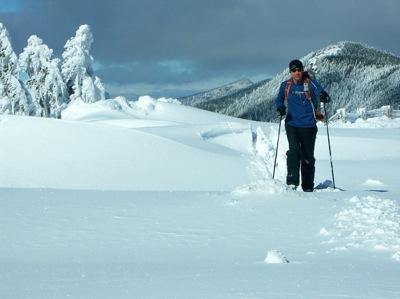
 Support Essential Coverage of Essential Places
Support Essential Coverage of Essential Places







Comments
Thank you for the great article. You did leave out the most Southern stretch of the Blue Ridge Parkway - from Mt Pisgah south. That stretch has the highest elevations of the parkway, thus the snow that falls tends to linger. "Our" stretch of the Parkway (Soco Gap area) is easy to get to from the house. Many people come to the Soco Gap entrance to snow sled, but few venture beyond the gates to the beauties. A trip the five miles up to Waterrock Knob provides beautiful views.
Quite a few cross country skiers use this stretch (and the stretch near Richland Balsam which is beautiful). And, sometimes, a certain team of Siberian Huskies can be seen doing their favorite thing. Now THAT is a sight you probably don't expect to see in North Carolina.
Thanks D.K.—
You seem to have missed it but I included the southernmost section of the Parkway, admittedly briefly!
"At times there’s also great skiing and snowshoeing on the southernmost
section of the road, in the area of the Shining Rock Wilderness south
of Asheville, and from Soco Gap, closer to the Great Smokies."
About those huskies—any sight "you don't normally see in NC" is a sight worth seeing in my book! Send us a photo or three and we'll see what we can do. Send to me: [email protected]